Austevoll Seafood Bundle
Unpacking Austevoll Seafood: How Does This Seafood Giant Thrive?
Dive into the dynamic world of Austevoll Seafood ASA, a leading Austevoll Seafood SWOT Analysis reveals its strategic positioning. This Norwegian-based seafood company has demonstrated remarkable financial prowess, with impressive Q1 2025 results. Its integrated model, spanning catching to distribution, makes it a key player in the global fishing industry.
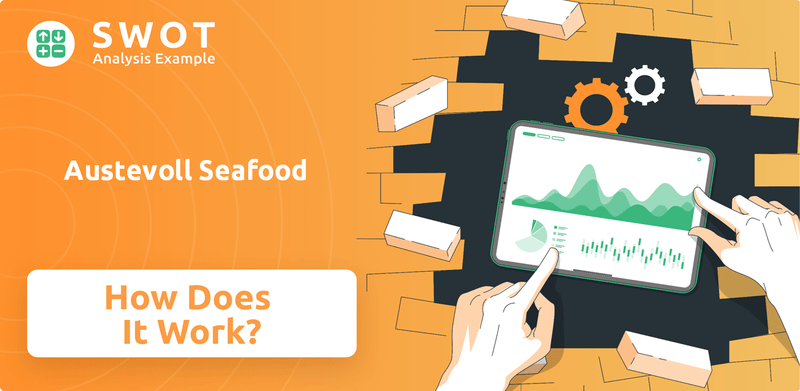
This analysis explores Austevoll operations, examining its diverse revenue streams and competitive advantages within the Norwegian seafood sector. Understanding the Seafood company's approach is vital for anyone interested in the seafood processing landscape, providing insights into its sustainability efforts and its response to market fluctuations. We'll explore questions like: How does Austevoll Seafood catch fish? What is Austevoll Seafood's product range? and How does Austevoll Seafood process fish?
What Are the Key Operations Driving Austevoll Seafood’s Success?
The core operations of Austevoll Seafood, a leading seafood company, are centered around a fully integrated value chain. This encompasses everything from wild catch and aquaculture to processing and global distribution. The company's structure and operations enable it to manage various stages of production, ensuring quality and efficiency from start to finish.
Austevoll Seafood's value proposition lies in its comprehensive control over the seafood supply chain. It creates value through strategic ownership in key subsidiaries and joint ventures. This approach allows for diversification across different seafood segments and geographies, which helps to mitigate risks.
Austevoll Seafood operates a fleet of 23 fishing vessels. These vessels have the capacity to catch between 400,000 and 500,000 metric tons (MT) of pelagic fish annually. This significant capacity is crucial for sustaining its operations and meeting global demand.
The company manages 35 processing plants. These plants handle between 1.6 to 2.0 million MT of raw material each year. This extensive processing capability is essential for transforming raw catches into marketable products.
Austevoll Seafood's product range includes pelagic fish, whitefish, and farmed salmon and trout. These products are supplied to global markets for human consumption and the fish and animal feed industries. The company's diverse product portfolio caters to various consumer needs.
Austevoll Seafood holds significant ownership stakes in key subsidiaries and joint ventures. These include a 52.7% stake in Lerøy Seafood Group ASA and a 90.1% stake in Austral Group S.A.A. in Peru. These strategic investments help to ensure control over the entire value chain.
Austevoll's operational effectiveness is enhanced by its vertical integration and diversified portfolio. This diversification helps to mitigate risks associated with price volatility and variable catch conditions. For example, a strong start to the fishing season in Peru in Q1 2025, with the anchoveta quota set at 3.0 million MT, contributed significantly to performance.
- The company focuses on sustainable harvesting practices.
- It adheres to international standards to reduce environmental impact.
- Sales operations are conducted in Norway, Europe, Asia, the USA, and South America.
- Austevoll Seafood's commitment to sustainability enhances its market differentiation.
Austevoll Seafood SWOT Analysis
- Complete SWOT Breakdown
- Fully Customizable
- Editable in Excel & Word
- Professional Formatting
- Investor-Ready Format
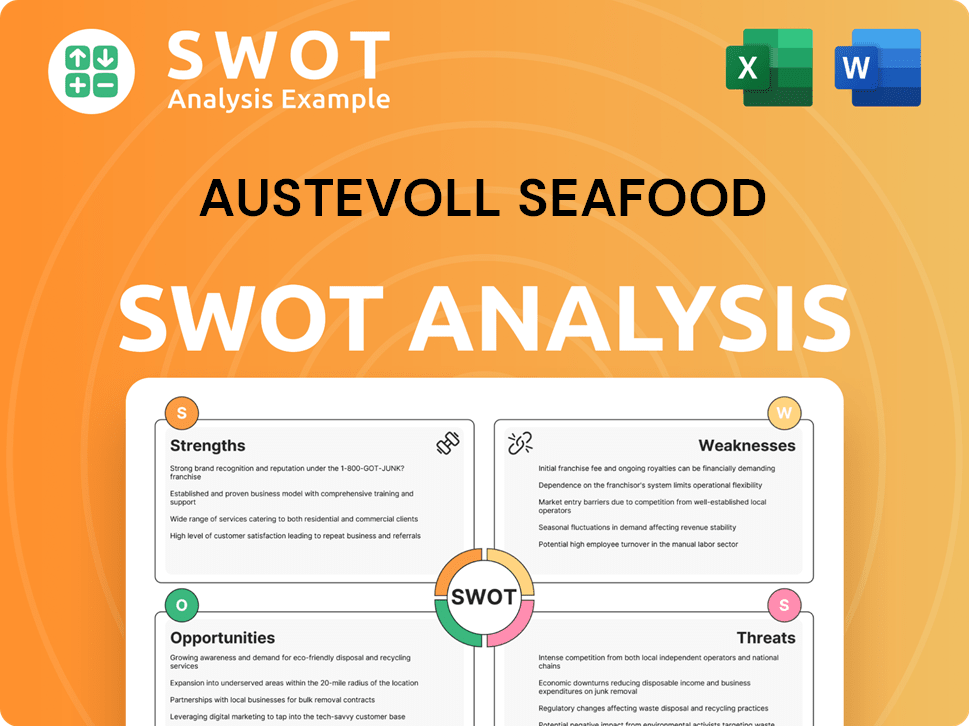
How Does Austevoll Seafood Make Money?
The revenue streams and monetization strategies of Austevoll Seafood are built upon a diversified operational model, encompassing wild catch, aquaculture, and processing. The company, with its subsidiary Lerøy Seafood Group ASA, generates revenue through various segments, showcasing its integrated approach within the fishing industry. In Q1 2025, the company reported a substantial increase in operating revenue, reflecting robust performance across its key sectors.
The company's financial performance is heavily influenced by its ability to manage and optimize its extensive value chain, from raw material acquisition to finished product sales. Despite facing fluctuations in market prices for certain products, such as fishmeal and fish oil, the company's focus on volume and strategic expansion continues to drive revenue growth. This approach is evident in its ambitious catch and production targets for 2025.
A detailed look into the Austevoll operations reveals a strategic focus on volume and value-added processing, which helps in navigating market volatility. The company's integrated value chain allows for efficient management and optimization of resources, ensuring sustained revenue generation. This strategy supports the company's financial health, as highlighted in a recent analysis of its Growth Strategy of Austevoll Seafood.
The major revenue streams for Austevoll Seafood include sales of farmed salmon and trout, pelagic fish products, whitefish products, and contributions from subsidiaries and joint ventures. These diverse income sources reflect the company's broad presence in the Norwegian seafood market and its global operations. The company's strategic focus on volume and value-added processing is evident in its financial performance.
- Sales of Farmed Salmon and Trout: Lerøy Seafood Group, the salmon and whitefish division, reported an operational EBIT of MNOK 1,049 in Q1 2025, up from MNOK 843 in Q1 2024. The slaughtered volume of salmon and trout significantly increased to 38,243 GWT in Q1 2025 from 26,376 GWT in Q1 2024.
- Sales of Pelagic Fish Products: This segment includes fish for human consumption, fishmeal, and fish oil. In Q1 2025, the pelagic segment saw significant activity, with the company aiming to catch over 500,000 tonnes of pelagic fish on its own quotas, mainly in Chile and Peru.
- Sales of Whitefish Products: Lerøy Seafood Group also contributes to whitefish operations.
- Dividends and Contributions from Subsidiaries and Joint Ventures: Austevoll obtains a significant portion of its cash flows from group contributions and dividends from its subsidiaries and joint ventures.
Austevoll Seafood PESTLE Analysis
- Covers All 6 PESTLE Categories
- No Research Needed – Save Hours of Work
- Built by Experts, Trusted by Consultants
- Instant Download, Ready to Use
- 100% Editable, Fully Customizable
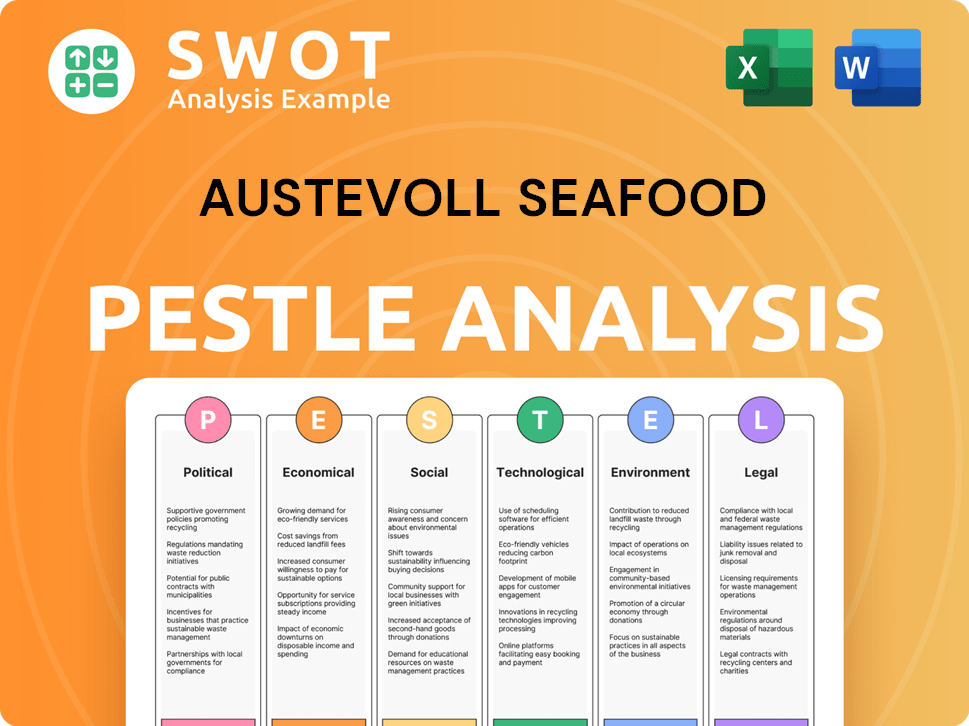
Which Strategic Decisions Have Shaped Austevoll Seafood’s Business Model?
Austevoll Seafood's journey has been marked by strategic acquisitions and a strong emphasis on integrating its operations while prioritizing sustainability. This approach has enabled the seafood company to build a robust and diversified business model. The company's evolution reflects a commitment to both expanding its market presence and adapting to the challenges of the fishing industry.
The company's history began with Austevoll Havfiske AS in 1981. A key strategic move was acquiring a significant share in Lerøy Seafood Group ASA, which expanded its core business into salmon farming and wildcatch fishing. Other important acquisitions include Welcon Invest AS and Austral Group S.A.A. in 2006, and the establishment of Pelagia Holding AS in 2014.
Operational challenges, such as fluctuating catch volumes, price volatility, and environmental issues, have shaped Austevoll's strategies. The company has focused on improving biological performance in its salmon farming operations, which has led to higher harvested volumes and cost reductions. Its geographically diverse operations help mitigate the impact of localized challenges, contributing to its overall resilience.
Established in 1981 as Austevoll Havfiske AS, the company has grown through strategic acquisitions. The acquisition of a majority share in Lerøy Seafood Group ASA was a pivotal move. Further expansions included Welcon Invest AS and Austral Group S.A.A. in 2006, and Pelagia Holding AS in 2014.
Strategic moves have focused on vertical integration and diversification. This includes expanding into salmon farming and wildcatch fishing. The company has also invested in fishmeal and fish oil production. These moves have broadened its market reach and operational capabilities.
Austevoll Seafood's competitive advantages include a vertically integrated business model. This covers fishing, farming, processing, and distribution. The company also benefits from its brand strength and a robust distribution network. Its commitment to sustainability is also a key differentiator.
The company is committed to sustainable harvesting and value-added processing. Austevoll Seafood is among the largest seafood companies in the world with a strong focus on sustainability. Their efforts include reducing their carbon footprint and maintaining high rankings in sustainability benchmarks.
Austevoll Seafood's success is driven by its vertically integrated model, brand strength, and commitment to sustainability. This approach allows for economies of scale and control over the value chain. The company's focus on sustainable practices and innovation further strengthens its position in the Norwegian seafood market and globally. For more insights, check out the Marketing Strategy of Austevoll Seafood.
- Vertical Integration: Covers fishing, farming, processing, and distribution.
- Brand Strength: Strong brand recognition and a wide distribution network.
- Sustainability: Commitment to sustainable harvesting and reducing environmental impact.
- Geographic Diversification: Operations in multiple regions to mitigate risks.
Austevoll Seafood Business Model Canvas
- Complete 9-Block Business Model Canvas
- Effortlessly Communicate Your Business Strategy
- Investor-Ready BMC Format
- 100% Editable and Customizable
- Clear and Structured Layout
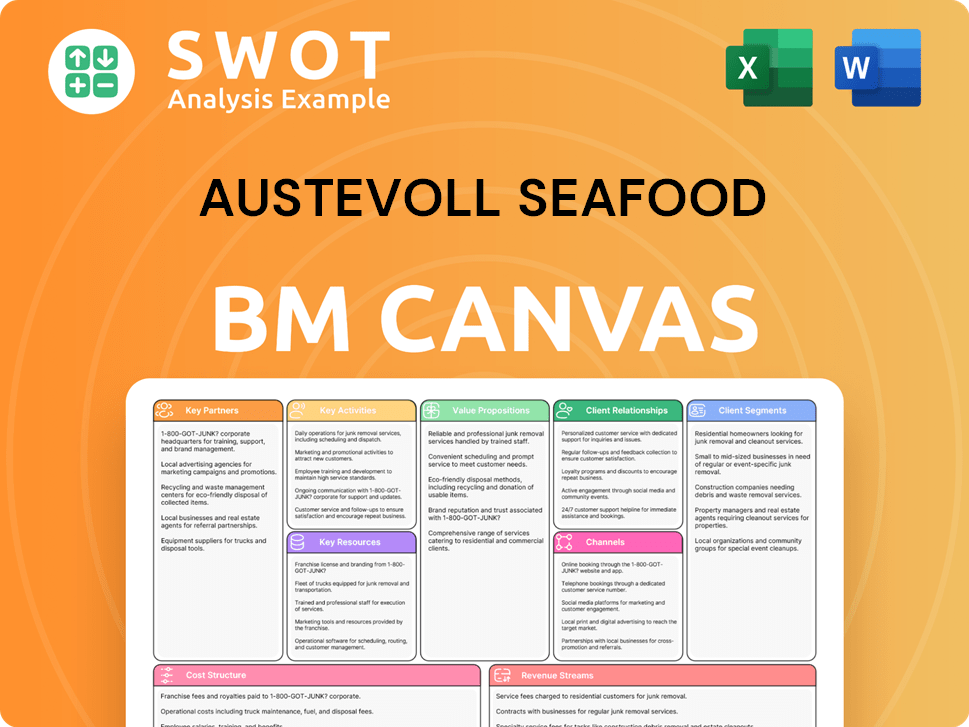
How Is Austevoll Seafood Positioning Itself for Continued Success?
As a major player in the global fishing industry, Austevoll Seafood holds a strong market position. The company's operations span several key segments, including pelagic, whitefish, and salmon, with a significant presence in Norway, Chile, Peru, and the North Atlantic. Its strategic investment in Lerøy Seafood Group ASA further strengthens its position in the salmon farming sector.
Despite its strong foundation, Austevoll Seafood faces several inherent risks. The seafood industry is subject to price volatility, influenced by supply fluctuations. Environmental challenges and regulatory changes also pose significant threats. The company's exposure to raw material prices and operational factors, like fishing conditions, further contributes to its risk profile.
Austevoll Seafood ranks among the world's largest seafood companies. It maintains a diverse portfolio across pelagic, whitefish, and salmon sectors. Its global reach extends to Norway, Europe, Asia, the USA, and South America, demonstrating a strong international presence.
The seafood sector faces earnings volatility due to fluctuating prices. Environmental issues, such as sea lice in aquaculture, and regulatory changes, like the 'resource rent' tax in Norway, can impact profitability. The company is also exposed to risks related to raw material prices and operational factors.
Austevoll Seafood anticipates strong seafood demand and limited salmon supply growth through 2026, supporting global prices. The company focuses on sustainable growth, aiming to increase its salmon/trout volume significantly. It has set ambitious environmental targets, including a 46% reduction in emissions by 2030.
The company is committed to expanding its profitability through strategic initiatives. Austevoll expects its subsidiaries to generate strong operating cash flows. The long-term perspective of the company is emphasized by its focus on sustainable growth and passing on a solid family business to the next generation.
Austevoll Seafood is focused on sustainable growth, both financially and environmentally. The company is aiming to increase its salmon/trout volume significantly, with projections for total Norway volumes to reach 195.0 thousand tonnes in 2025. This commitment is further supported by ambitious environmental targets.
- The company aims to reduce total Scope 1, 2, and 3 emissions by 46% by 2030 from a 2019 base year.
- Austevoll's management expresses confidence in passing on a solid family business, underscoring a long-term perspective.
- The company anticipates its operating subsidiaries will continue to generate strong operating cash flows.
- For a deeper dive into the company's strategic approach, consider the Growth Strategy of Austevoll Seafood.
Austevoll Seafood Porter's Five Forces Analysis
- Covers All 5 Competitive Forces in Detail
- Structured for Consultants, Students, and Founders
- 100% Editable in Microsoft Word & Excel
- Instant Digital Download – Use Immediately
- Compatible with Mac & PC – Fully Unlocked
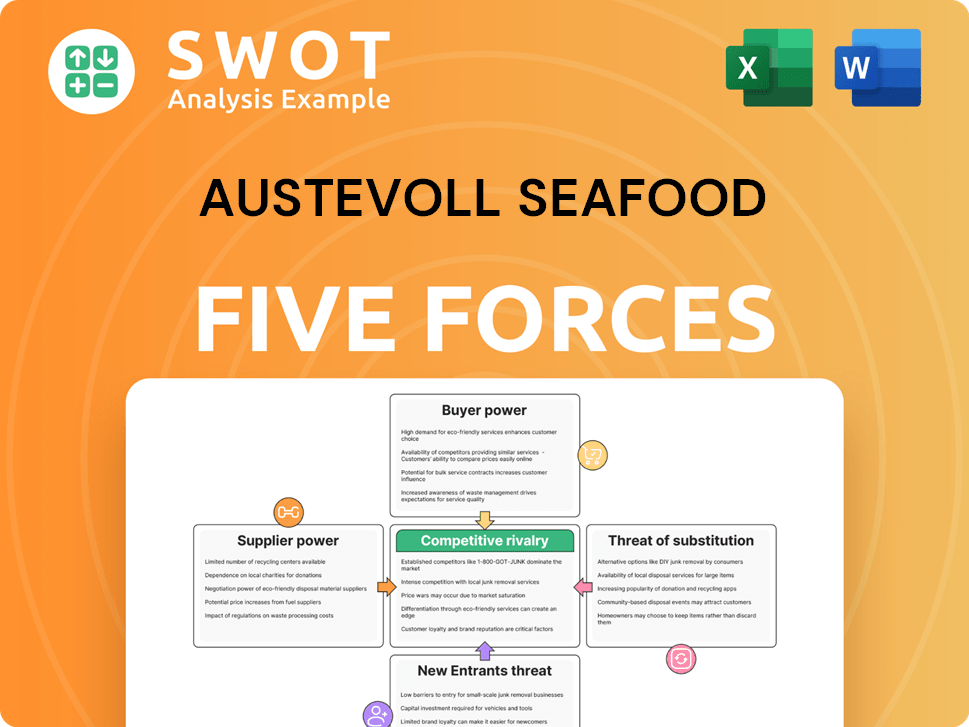
Related Blogs
- What are Mission Vision & Core Values of Austevoll Seafood Company?
- What is Competitive Landscape of Austevoll Seafood Company?
- What is Growth Strategy and Future Prospects of Austevoll Seafood Company?
- What is Sales and Marketing Strategy of Austevoll Seafood Company?
- What is Brief History of Austevoll Seafood Company?
- Who Owns Austevoll Seafood Company?
- What is Customer Demographics and Target Market of Austevoll Seafood Company?
Disclaimer
All information, articles, and product details provided on this website are for general informational and educational purposes only. We do not claim any ownership over, nor do we intend to infringe upon, any trademarks, copyrights, logos, brand names, or other intellectual property mentioned or depicted on this site. Such intellectual property remains the property of its respective owners, and any references here are made solely for identification or informational purposes, without implying any affiliation, endorsement, or partnership.
We make no representations or warranties, express or implied, regarding the accuracy, completeness, or suitability of any content or products presented. Nothing on this website should be construed as legal, tax, investment, financial, medical, or other professional advice. In addition, no part of this site—including articles or product references—constitutes a solicitation, recommendation, endorsement, advertisement, or offer to buy or sell any securities, franchises, or other financial instruments, particularly in jurisdictions where such activity would be unlawful.
All content is of a general nature and may not address the specific circumstances of any individual or entity. It is not a substitute for professional advice or services. Any actions you take based on the information provided here are strictly at your own risk. You accept full responsibility for any decisions or outcomes arising from your use of this website and agree to release us from any liability in connection with your use of, or reliance upon, the content or products found herein.